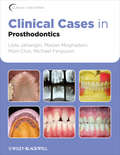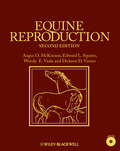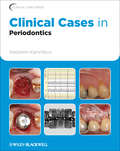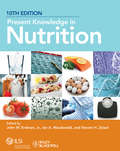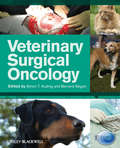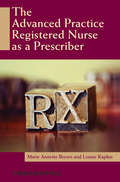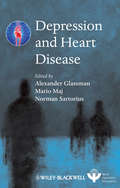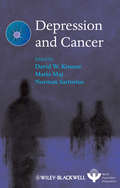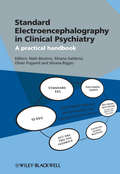- Table View
- List View
Clinical Cases in Avian and Exotic Animal Hematology and Cytology (Coursesmart Ser.)
by Terry Campbell Krystan R. GrantClinical Cases in Avian and Exotic Animal Hematology and Cytology demonstrates how to use hemic cytology and cytodiagnosis as part of the assessment of an exotic animal patient, taking the reader through nearly 100 actual clinical cases. With a focus on cytological interpretation, the hands-on, practical approach facilitates learning, teaching, and comprehension. Well illustrated throughout, Clinical Cases in Avian and Exotic Animal Hematology and Cytology is a helpful guide for exotics veterinarians, zoo and aquarium veterinarians, and veterinary hematologists.
Clinical Cases in Prosthodontics (Clinical Cases (Dentistry) #9)
by Leila Jahangiri Marjan Moghadam Mijin Choi Michael FergusonWiley-Blackwell's "Clinical Cases" series is designed to recognize the centrality of clinical cases to the profession by providing actual cases with an academic backbone. Clinical Cases in Prosthodontics grounds itself in core principles of this rehabilitative specialty and demonstrates their practical, every-day application through range of case presentations building from simple to complex and from common to rare. This unique approach supports the new trend in case-based and problem-based learning, thoroughly covering topics ranging from conventional complete denture prostheses to full mouth rehabilitation using both implant and tooth-supported prostheses. Each case begins with a short description of the initial patient presentation and the learning objectives and goals the subsequent case discussion will demonstrate. This is accompanied by relevant medical and dental histories, notes on extra-oral and soft tissue examination and a thorough list of clinical findings, all presented in bulleted from to facilitate ease of learning. Clinical decision making factors are then discussed in detail, well illustrated with multiple clinical photos showing progressive stages of treatment. Cases conclude with review questions and relevant literature citations supporting each answer. Ideal for practitioners and students alike, Clinical Cases in Prosthodontics is the ultimate resource linking evidence-based research to every-day application.
Equine Reproduction
by Edward L. Squires Wendy E. Vaala Dickson D. Varner Angus O. McKinnonNow in a much-anticipated two-volume new edition, this gold-standard reference stands as the most comprehensive and authoritative text on equine reproduction. Serving theriogenologists, practitioners and breeders worldwide as a one-stop resource for the reproductive assessment and management of equine patients, Equine Reproduction, Second Edition provides detailed information on examination techniques, breeding procedures, pregnancy diagnosis and management, reproductive tract diseases and surgery, and foaling. A companion CD offers hundreds of images from the book in color. For the Second Edition, the stallion, mare and foal sections have been thoroughly updated and revised to include the latest information on every subject. New topics include discussion of nutritional and behavioral factors in the broodmare and stallion, parentage testing, fetal sexing and the health and management of older foals, weanlings and yearlings. Additionally, this outstanding Second Edition features a new section on assisted reproductive techniques, including detailed information on artificial insemination, in-vitro fertilization, embryo transfer and technology.
Health Behavior Change in the Dental Practice
by Christoph A. Ramseier Jean E. SuvanHealth Behavior Change in the Dental Practice presents an overview of health behavior change, focusing on the spirit of motivational interviewing. Targeting the clinical application of the principles, the book applies lessons learned from the field of general and behavioral medicine to the dental practice. By presenting a series of clinical examples and accompanying dialogue, the book guides the reader in using motivational interviewing techniques as tools for oral hygiene education, tobacco use cessation, and dietary counseling. Health Behavior Change in the Dental Practice supports the trend towards risk management in oral health care, offering practical guidance to promote health behavior change in patients.
Clinical Cases in Periodontics (Clinical Cases (Dentistry) #42)
by Nadeem KarimbuxWiley-Blackwell's "Clinical Cases" series is designed to recognize the centrality of clinical cases to the profession by providing actual cases with an academic backbone. Clinical Cases in Periodontics describes the core principles of periodontics and demonstrates their practical, every-day application through a range of representative cases building from the simple to the complex and from the common to the rare. This unique approach supports the new trend in case-based and problem-based learning, thoroughly covering topics ranging from infant oral health to complex pulp therapy. Highly illustrated in full color, Clinical Cases in Periodontics utilizes a format that fosters independent learning and prepares the reader for case-based examinations. The book presents actual clinical cases, accompanied by academic commentary, that question and educate the reader about essential topics in periodontics. The book begins with a set of cases illustrating the most common diagnoses and the key decisions and evaluations leading up to them. Subsequent chapters continue in this style, presenting exemplary cases as the basis of discussing various treatment options including surgical and non-surgical treatment, regenerative therapy, mucogingival therapy, and interdisciplinary treatments. Concluding chapters cover implant site development and general prevention of such periodontal diseases. Clinical Cases in Periodontics's case-based format is particularly useful for pre-doctoral dental students, post-graduate residents and practitioners, both as a textbook from which to learn about the challenging and absorbing nature of periodontology, and also as a reference tool to help with treatment planning when complex cases present in the dental office.
Nursing Care in Pediatric Respiratory Disease
by Concettina TolomeoPediatric respiratory disorders are responsible for a number of acute and chronic health conditions and are a leading cause of pediatric emergency room visits and hospitalizations. More than ever, nurses and nurse practitioners must have an understanding of the anatomy, pathophysiology, diagnosis and state of the art treatments in pediatric respiratory disease as they are often the first to come in contact with and recognize respiratory problems in children. Nursing Care in Pediatric Respiratory Disease seeks to provide both nurses and nurse practitioners with this information in order to aid them in the diagnosis and treatment of children suffering from acute and chronic respiratory disorders. Nursing Care in Pediatric Respiratory Disease opens with an overview of the anatomy and physiology of the respiratory system, best practices for assessing respiratory symptoms in children, and common respiratory therapies and treatment methods. It then proceeds through an examination of varying acute and chronic upper and lower respiratory diseases spanning from asthma and cystic fibrosis to vocal cord paralysis and sinusitis in both hospital and ambulatory settings. Nursing Care in Pediatric Respiratory Disease provides nurses and other health care providers with a comprehensive and practical resource which allows them to collaborate and advocate more effectively, as well as educate both the family and child in management of respiratory disorders.
Clinical Cases in Periodontics (Clinical Cases (Dentistry) #42)
by Nadeem KarimbuxWiley-Blackwell's "Clinical Cases" series is designed to recognize the centrality of clinical cases to the profession by providing actual cases with an academic backbone. Clinical Cases in Periodontics describes the core principles of periodontics and demonstrates their practical, every-day application through a range of representative cases building from the simple to the complex and from the common to the rare. This unique approach supports the new trend in case-based and problem-based learning, thoroughly covering topics ranging from infant oral health to complex pulp therapy. Highly illustrated in full color, Clinical Cases in Periodontics utilizes a format that fosters independent learning and prepares the reader for case-based examinations. The book presents actual clinical cases, accompanied by academic commentary, that question and educate the reader about essential topics in periodontics. The book begins with a set of cases illustrating the most common diagnoses and the key decisions and evaluations leading up to them. Subsequent chapters continue in this style, presenting exemplary cases as the basis of discussing various treatment options including surgical and non-surgical treatment, regenerative therapy, mucogingival therapy, and interdisciplinary treatments. Concluding chapters cover implant site development and general prevention of such periodontal diseases. Clinical Cases in Periodontics's case-based format is particularly useful for pre-doctoral dental students, post-graduate residents and practitioners, both as a textbook from which to learn about the challenging and absorbing nature of periodontology, and also as a reference tool to help with treatment planning when complex cases present in the dental office.
Nursing Care in Pediatric Respiratory Disease
by Concettina TolomeoPediatric respiratory disorders are responsible for a number of acute and chronic health conditions and are a leading cause of pediatric emergency room visits and hospitalizations. More than ever, nurses and nurse practitioners must have an understanding of the anatomy, pathophysiology, diagnosis and state of the art treatments in pediatric respiratory disease as they are often the first to come in contact with and recognize respiratory problems in children. Nursing Care in Pediatric Respiratory Disease seeks to provide both nurses and nurse practitioners with this information in order to aid them in the diagnosis and treatment of children suffering from acute and chronic respiratory disorders. Nursing Care in Pediatric Respiratory Disease opens with an overview of the anatomy and physiology of the respiratory system, best practices for assessing respiratory symptoms in children, and common respiratory therapies and treatment methods. It then proceeds through an examination of varying acute and chronic upper and lower respiratory diseases spanning from asthma and cystic fibrosis to vocal cord paralysis and sinusitis in both hospital and ambulatory settings. Nursing Care in Pediatric Respiratory Disease provides nurses and other health care providers with a comprehensive and practical resource which allows them to collaborate and advocate more effectively, as well as educate both the family and child in management of respiratory disorders.
Present Knowledge in Nutrition
by John W. Erdman Ian A. MacDonald Steven H. ZeiselPresent Knowledge in Nutrition, 10th Edition provides comprehensive coverage of all aspects of human nutrition, including micronutrients, systems biology, immunity, public health, international nutrition, and diet and disease prevention. This definitive reference captures the current state of this vital and dynamic science from an international perspective, featuring nearly 140 expert authors from 14 countries around the world. Now condensed to a single volume, this 10th edition contains new chapters on topics such as epigenetics, metabolomics, and sports nutrition.The remaining chapters have been thoroughly updated to reflect recent developments. Suggested reading lists are now provided for readers wishing to delve further into specific subject areas. An accompanying website provides book owners with access to an image bank of tables and figures as well as any updates the authors may post to their chapters between editions. Now available in both print and electronic formats, the 10th edition will serve as a valuable reference for researchers, health professionals, and policy experts as well as educators and advanced nutrition students.
Present Knowledge in Nutrition
by John W. Erdman Jr. Ian A. Macdonald Steven H. ZeiselPresent Knowledge in Nutrition, 10th Edition provides comprehensive coverage of all aspects of human nutrition, including micronutrients, systems biology, immunity, public health, international nutrition, and diet and disease prevention. This definitive reference captures the current state of this vital and dynamic science from an international perspective, featuring nearly 140 expert authors from 14 countries around the world. Now condensed to a single volume, this 10th edition contains new chapters on topics such as epigenetics, metabolomics, and sports nutrition.The remaining chapters have been thoroughly updated to reflect recent developments. Suggested reading lists are now provided for readers wishing to delve further into specific subject areas. An accompanying website provides book owners with access to an image bank of tables and figures as well as any updates the authors may post to their chapters between editions. Now available in both print and electronic formats, the 10th edition will serve as a valuable reference for researchers, health professionals, and policy experts as well as educators and advanced nutrition students.
Implant Site Development
by Michael Sonick Debby HwangWith the desire for dental implant therapy ever escalating, clinicians are faced with the challenge of augmenting deficient natural physiology to provide effective sites for implantation. Implant Site Development helps the clinician decide if, when, and how to create a ridge site amenable to implantation. This practical book offers solutions to many implant site preservation scenarios, discussing different treatment options, timing, a variety of materials and techniques, and their application to the clinical practice. With a unique integrated clinical approach, Implant Site Development covers a range of site development techniques. Highly illustrated, Implant Site Development presents diagrams and clinical photographs to aid with clinical judgment and will prove useful for any dental professional involved in implant therapy, from general practitioners to prosthodontists, but especially surgeons. This literature-based, yet user-friendly, reference will be indispensable to the novice or veteran clinician.
Implant Site Development
by Michael Sonick Debby HwangWith the desire for dental implant therapy ever escalating, clinicians are faced with the challenge of augmenting deficient natural physiology to provide effective sites for implantation. Implant Site Development helps the clinician decide if, when, and how to create a ridge site amenable to implantation. This practical book offers solutions to many implant site preservation scenarios, discussing different treatment options, timing, a variety of materials and techniques, and their application to the clinical practice. With a unique integrated clinical approach, Implant Site Development covers a range of site development techniques. Highly illustrated, Implant Site Development presents diagrams and clinical photographs to aid with clinical judgment and will prove useful for any dental professional involved in implant therapy, from general practitioners to prosthodontists, but especially surgeons. This literature-based, yet user-friendly, reference will be indispensable to the novice or veteran clinician.
Veterinary Surgical Oncology
by Simon T. Kudnig Bernard SeguinVeterinary Surgical Oncology provides in-depth coverage of surgical techniques for treating cancer in small animal patients. Organized by body system, each chapter presents detailed, well-illustrated descriptions of surgical procedures, with additional information on diagnostic testing, aftercare, outcomes, and prognosis. Edited and authored by members of the Veterinary Society of Surgical Oncologists, Veterinary Surgical Oncology's comprehensive coverage of surgical treatments for cancer provides an invaluable decision-making tool and is equally useful for veterinary surgeons and veterinary oncologists. The book begins with introductory chapters on the principles of surgical oncology, multimodal therapy, and interventional radiology, then presents chapters on surgical techniques in all anatomical structures, including procedures not well covered in existing literature. The first book to focus on the surgical aspects of cancer treatment, Veterinary Surgical Oncology is an essential reference for anyone with an interest in surgical oncology.
Veterinary Surgical Oncology
by Simon T. Kudnig Bernard SéguinVeterinary Surgical Oncology provides in-depth coverage of surgical techniques for treating cancer in small animal patients. Organized by body system, each chapter presents detailed, well-illustrated descriptions of surgical procedures, with additional information on diagnostic testing, aftercare, outcomes, and prognosis. Edited and authored by members of the Veterinary Society of Surgical Oncologists, Veterinary Surgical Oncology's comprehensive coverage of surgical treatments for cancer provides an invaluable decision-making tool and is equally useful for veterinary surgeons and veterinary oncologists. The book begins with introductory chapters on the principles of surgical oncology, multimodal therapy, and interventional radiology, then presents chapters on surgical techniques in all anatomical structures, including procedures not well covered in existing literature. The first book to focus on the surgical aspects of cancer treatment, Veterinary Surgical Oncology is an essential reference for anyone with an interest in surgical oncology.
The Advanced Practice Registered Nurse as a Prescriber
by Marie Annette Brown Louise Kaplan Marie-Annette BrownA new era of opportunity is emerging for advanced practice registered nurses (APRNs) to increasingly address gaps in access to quality healthcare. APRNs must be prepared to practice to the full scope of their education and abilities. As more and more states pass legislation enhancing prescriptive authority and fully autonomous practice for APRNs, a comprehensive resource on prescribing practices is needed. The increasing demands of today's fast-paced healthcare environment require a new level of prescriber expertise. Knowledge about medication characteristics and effectiveness must be accompanied by an understanding of the context and process of prescribing. The Advanced Practice Registered Nurse as a Prescriber provides practicing APRNs and students with the information necessary to make fully informed, rational and ethical decisions as prescribers. This book opens with an overview of the role of the APRN prescriber and moves on to discussing practical issues such as managing difficult patient situations, special considerations when prescribing controlled substances, the influence of pharmaceutical marketing, state regulation, and legal aspects of prescribing. The book also examines barriers to prescribing, and the concluding chapter underscores key information to build cultural competence when prescribing. An evidence-based resource for all APRNs and APRN students, The Advanced Practice Registered Nurse as a Prescriber provides a comprehensive and practical resource essential for APRNs in all advanced practice roles.
The Advanced Practice Registered Nurse as a Prescriber
by Marie Annette Brown Louise KaplanA new era of opportunity is emerging for advanced practice registered nurses (APRNs) to increasingly address gaps in access to quality healthcare. APRNs must be prepared to practice to the full scope of their education and abilities. As more and more states pass legislation enhancing prescriptive authority and fully autonomous practice for APRNs, a comprehensive resource on prescribing practices is needed. The increasing demands of today's fast-paced healthcare environment require a new level of prescriber expertise. Knowledge about medication characteristics and effectiveness must be accompanied by an understanding of the context and process of prescribing. The Advanced Practice Registered Nurse as a Prescriber provides practicing APRNs and students with the information necessary to make fully informed, rational and ethical decisions as prescribers. This book opens with an overview of the role of the APRN prescriber and moves on to discussing practical issues such as managing difficult patient situations, special considerations when prescribing controlled substances, the influence of pharmaceutical marketing, state regulation, and legal aspects of prescribing. The book also examines barriers to prescribing, and the concluding chapter underscores key information to build cultural competence when prescribing. An evidence-based resource for all APRNs and APRN students, The Advanced Practice Registered Nurse as a Prescriber provides a comprehensive and practical resource essential for APRNs in all advanced practice roles.
Child and Adolescent Behavioral Health: A Resource for Advanced Practice Psychiatric and Primary Care Practitioners in Nursing
by Edilma L. Yearwood Geraldine S. Pearson Jamesetta A. NewlandAs an increasing number of children and adolescents with psychiatric symptoms go unrecognized in our current healthcare system, the ability to identify and treat these issues in multiple healthcare settings has become vitally important. With access to primary care providers increasing and a shortage of child psychiatric providers, collaboration between psychiatric, pediatric and family advanced practice nurses is essential to improving care for this vulnerable population. Child and Adolescent Behavioral Health provides a practical reference to aid in this endeavour. Written and reviewed by over 70 nurse experts, it is a must-have reference for all practitioners caring for children and adolescents.
Child and Adolescent Behavioral Health: A Resource for Advanced Practice Psychiatric and Primary Care Practitioners in Nursing
by Edilma L. YearwoodAs an increasing number of children and adolescents with psychiatric symptoms go unrecognized in our current healthcare system, the ability to identify and treat these issues in multiple healthcare settings has become vitally important. With access to primary care providers increasing and a shortage of child psychiatric providers, collaboration between psychiatric, pediatric and family advanced practice nurses is essential to improving care for this vulnerable population. Child and Adolescent Behavioral Health provides a practical reference to aid in this endeavour. Written and reviewed by over 70 nurse experts, it is a must-have reference for all practitioners caring for children and adolescents.
Ethical Issues in Forensic Psychiatry: Minimizing Harm
by Robert L. SadoffEthical medical practice and treatment in psychiatry are based on the concept of first do no harm. However, this cannot, and does not, apply to forensic cases where there is no doctor–patient relationship and the forensic psychiatrist may indeed cause harm to the examinee. In this book, Robert Sadoff analyzes the ethical issues affecting forensic psychiatric practice, especially those promulgated by the American Academy of Psychiatry and the Law. Within those guidelines, he looks at individual bias, vulnerability of the examinee, and potential harm to the mental health professional. The book discusses each of the procedures of the forensic expert separately with respect to minimizing harm. It has been written with an international audience in mind and features chapters reviewing the European and UK perspectives, by Emanuele Valenti and John Baird, respectively. Robert Sadoff addresses the long-term harm that can be either avoided or minimized through careful planning and application of ethical principles. He is not advocating that the harm can be totally eliminated, because that is impossible in the adversarial system in which forensic psychiatrists work. However, there are means by which harm may be minimized if care is taken during the assessment, the report writing, and the testimony phase of the proceedings. The book develops the scope of forensic psychiatry from the standpoint of administrative, civil and criminal cases. It presents the practical issues involved in conducting forensic psychiatric assessments under various conditions plus special considerations, such as bias, minimizing harm, developing a therapeutic approach, and elaborating on various vulnerable individuals who are frequently examined in forensic cases. These include juveniles, mentally retarded, autistic, sexual assault victims, the elderly, the organically damaged, the psychotic, and mentally disabled prisoners. Immigrants are covered in a chapter by Solange Margery Bertoglia. The ethical issues in conducting forensic psychiatric examinations and presenting psychiatric testimony in court are examined and discussed. Cases illustrating the difficulties involved punctuate the presentation. The book closes with a fascinating account of the legal perspective by Donna Vanderpool. In summary, this book illustrates the ethical and practical issues that affect forensic psychiatric practice. The question is not what we do, but how we do it, and which standards, ethical guidelines and personal values contribute to the total picture. Despite the fact that we cannot always adhere to the doctrine of "primum non nocere," we can minimize the harm caused inherently by the adversarial system in which we participate. Praise for Ethical Issues in Forensic Psychiatry "One of the founding giants of the forensic psychiatric field has written here far more than a "mere" ethics textbook. Instead, this compendium serves multiple purposes: it is a valuable primer on forensic techniques of examination and testimony, a model of best forensic practices, and an instruction on the most appropriately civilized way in which to conduct oneself as a forensic psychiatrist. The success of these multiple accomplishments clearly derives from characteristics of the author. In both sage advice to practitioners and in many revealing case examples, Dr. Sadoff displays the tact, good manners and sensitivity of a consummate gentleman – a term not always associated with the hurly-burly of courtroom work. The book's primary focus on avoiding harm to all the parties involved in the work places it on the moral high ground of the legal system in which participating clinicians must find a place." Thomas G. Gutheil, MD, Professor of Psychiatry and Co-Founder, Program in Psychiatry and the Law, Beth Israel Deaconess Medical Center, Harvard Medical School
Depression and Heart Disease
by Alexander Glassman Mario M. Maj Norman SartoriusRecently, there has been a growing awareness of the multiple interrelationships between depression and various physical diseases. Patients with psychiatric problems, particularly depression, may be more susceptible to cardiovascular disorders. Depression and Heart Disease synthesizes current evidence, including some previously unpublished data, in a concise, easy-to-read format. The authors succinctly describe the epidemiology, pathogenesis (including cytokines and genetics), and risk factors of the comorbidity between depression and heart disease. The book also reviews the best pharmacological and psychotherapeutic approaches for people with this comorbidity.
Depression and Cancer (World Psychiatric Association #14)
by David W. Kissane Norman SartoriusRecently, there has been a growing awareness of the multiple interrelationships between depression and cancer. Depression and Cancer is devoted to the interaction between these disorders. The book examines various aspects of this comorbidity and describes how the negative consequences of depression in cancer could be avoided or ameliorated, given that effective depression treatments for cancer patients are available. Renowned psychiatrists and oncologists summarize the latest evidence on the epidemiology, pathogenesis, screening and recognition, and cultural and public health implications of depression in persons with cancer, among other topics.
Understanding Children and Young People's Mental Health
by Anne Claveirole Martin GaughanUnderstanding Children and Young People's Mental Health has been designed to help the student and newly qualified health care professional to familiarise themselves with the key theoretical frameworks underpinning the field of children and young people's mental health. It explores the mental health challenges that children and young people face, and how we as adults can work alongside them to help them face and overcome such challenges. This book provides comprehensive information on the theory and practice of particular mental health difficulties which children and young people may have to face, including self-harm, depression, suicide, child abuse, eating disorders, substance misuse, and early onset psychosis. Understanding Children and Young People's Mental Health is essential reading for pre-registration students in nursing and healthcare on child and mental health branches, and for newly qualified nursing, health and social care practitioners who work with children and young people. Brings together specialist practitioners and academics in the field Incorporates the latest guidelines and policies Practical and accessible in style with learning outcomes, activities, examples and recommended reading in each chapter
Teaching Psychiatry: Putting Theory into Practice
by Linda Gask Bulent Coskun David A. BaronIn psychiatry, as in all of medicine, clinicians are frequently involved in training students and residents yet few have themselves been trained in pedagogy. Improving the quality of psychiatric education should both improve the quality of psychiatric care and make the profession more attractive to medical students. Written by a team of international experts with many years of experience, this comprehensive text takes a globally relevant perspective on providing practical instruction and advice on all aspects of teaching psychiatry. It covers learning from undergraduate and postgraduate level to primary medical and community settings, enabling readers to find solutions to the problems they are facing and become aware of potential issues which they can anticipate and be prepared to address. The book discusses curriculum development using examples from around the world, in order to provide trainees with the basic attitudes, knowledge and skills they require to practise psychiatry. Features: Instruction on developing a curriculum for Residency training, teaching interviewing skills, teaching psychotherapy and using new technology Innovative ways of engaging medical students in psychiatry and developing their interest in the specialty, including experience with new types of elective and research options and development of roles for students in patient care Focuses throughout on how to teach rather than what to teach Includes descriptions of workplace-based assessments Discussions of both theoretical and practical perspectives and examples of particular innovations in the field using case studies Presented in a thoroughly readable and accessible manner, this book is a primary resource for all clinicians involved in teaching psychiatry to medical students and trainees.
Standard Electroencephalography in Clinical Psychiatry: A Practical Handbook
by Nash N. Boutros Silvana Galderisi Oliver Pogarell Silvana RiggioThis book provides a concise overview of the possible clinical applications of standard EEG in clinical psychiatry. After a short history, the book describes the physiologic basis of the EEG signal, then reviews the principles of EEG in terms of technical backgrounds and requirements, EEG recording and signal analysis, with plentiful illustrations of the most frequent biological or technical artefacts. Normal EEG patterns and waveforms for easy reference are clearly presented, before the detailed description of abnormal patterns. With the basic information in hand, the reader progresses to an account of the role of EEG in the diagnostic work up in psychiatry, covering nonconvulsive status epilepticus, frontal lobe seizures and non-epileptic seizures. The clinical application of EEG in both childhood and adult disorders follows, including many case vignettes. The effects of psychotropic drugs on EEG are highlighted. The book closes with a discussion of currently available certification venues for Clinical Neurophysiology along with limitations of each venue. It calls for the development of training guidelines and certification processes specific to Psychiatric Electrophysiology. The material is clearly presented throughout, with plenty of figures, tables with summaries of relevant findings, flow diagrams for diagnostic work-up, boxes with learning points, and short lists of key references. We fully expect the book will become the standard teaching source for psychiatry residents and fellows, as well as a useful resource for practising psychiatrists and clinical psychologists. Praise for the book: "This distinguished group of editors has put together chapters that represent an excellent practical handbook on electroencephalography in clinical psychiatry, now a very important topic. I highly recommend it not only to psychiatrists, but also to anyone interested in neuroscience." John R. Hughes, DM (Oxon), MD, PhD, Professor of Neurology, University of Illinois Medical Center, at Chicago, Illinois, USA
Teaching Psychiatry: Putting Theory into Practice
by Linda Gask Bulent Coskun David BaronIn psychiatry, as in all of medicine, clinicians are frequently involved in training students and residents yet few have themselves been trained in pedagogy. Improving the quality of psychiatric education should both improve the quality of psychiatric care and make the profession more attractive to medical students. Written by a team of international experts with many years of experience, this comprehensive text takes a globally relevant perspective on providing practical instruction and advice on all aspects of teaching psychiatry. It covers learning from undergraduate and postgraduate level to primary medical and community settings, enabling readers to find solutions to the problems they are facing and become aware of potential issues which they can anticipate and be prepared to address. The book discusses curriculum development using examples from around the world, in order to provide trainees with the basic attitudes, knowledge and skills they require to practise psychiatry. Features: Instruction on developing a curriculum for Residency training, teaching interviewing skills, teaching psychotherapy and using new technology Innovative ways of engaging medical students in psychiatry and developing their interest in the specialty, including experience with new types of elective and research options and development of roles for students in patient care Focuses throughout on how to teach rather than what to teach Includes descriptions of workplace-based assessments Discussions of both theoretical and practical perspectives and examples of particular innovations in the field using case studies Presented in a thoroughly readable and accessible manner, this book is a primary resource for all clinicians involved in teaching psychiatry to medical students and trainees.

